AMD Releases Radeon Software Crimson ReLive Edition 17.7.2: ReLive Edition Refined for Gamers and Developers
by Nate Oh on July 26, 2017 5:00 PM ESTRadeon GPU Profiler
In many ways, the new Radeon GPU Profiler (RGP) is the marquee feature for game and software developers in 17.7.2. While select developers (such as teams at DICE, RenderDoc, and Valve) have had early access to RGP for the last couple months as part of a beta program, AMD is publicly announcing and launching RGP today, offering official API support for DX12 and Vulkan, and with Windows 7, Windows 10, and Ubuntu 16.04 (Linux) as the supported OSes. Hardware-wise, RGP is compatible with recent GCN-based products, with the RX 400, RX 500, and Fiji-based cards being officially supported.
AMD compares RGP with enabling a “white box” style console development workflow for GPUs on PC, as opposed to the typical “black box” experience. And before anyone asks, AMD’s experience with console development was only an indirect influence with respect to RGP, although consoles and console tools are also utilizing GCN’s built-in low-level thread trace features. Like how certain changes in Radeon Software came from user feedback, RGP came about due to requests from AMD’s ISV partners who liked those console tools and requested something similar for PC.
In the field of PC GPU performance tuning and debugging, developers will already be familiar with Microsoft’s PIX for Windows, of which AMD has released an AMD plugin this May. While RGP has no direct relation to PIX, it “complements the functionality offered with PIX for Windows, offering additional insight into the GPU not available today in PIX.” Otherwise, the AMD plugin for PIX continues to be actively developed, and is a separate initiative from RGP. Similarly, AMD stated that RGP is not competing with existing solutions like RenderDoc, instead choosing to collaborate with the developers and ensure that RenderDoc and RGP complement each other.
Using GCN’s hardware thread tracing feature, RGP combines that data with information from the driver and application, where a single frame could be presented and visualized as shown in the slide above. For developers, this can lay out what is exactly happening in the GPU and where performance could easily be increased, including analyzing async compute usage, event timing, pipeline stalls, and bottlenecks. With a vast amount of features and functionality, RGP also includes a large amount of documentation and a sample trace to peruse.
As its documentation outlines, RGP itself is actually comprised of four components:
- Radeon Developer Mode Driver – This is shipped as part of the AMD public Crimson driver from 17.30 onwards and supports the developer mode features required for profiling.
- Radeon Developer Service (RDS) – A system tray application that unlocks the Developer Mode Driver features and supports communications with high level tools.
- Radeon Developer Panel (RDP) – A GUI application that allows the developer to configure driver settings and generate profiler trace data from DirectX12 and Vulkan applications.
- Radeon GPU Profiler (RGP) – A GUI tool used to visualize and analyze the trace data.
As mentioned earlier, the Radeon Developer Mode Driver is the heart of RGP, exposing internal driver settings and experimental features that were previously only available to developers on a case-by-case basis. These settings are customizable and allows dumping of trace files for RGP to analyze.
RGP documentation does state that RGP will not work with older APIs such as DX11 and OpenGL. In terms of major known issues, RGP only works on a single AMD GPU, and will not work with Windows Insider Editions, while driver settings for Vulkan are not available yet.
AMD LiquidVR 360 SDK
Building upon last year's LiquidVR additions, AMD has brought yet another asset to the LiquidVR platform: LiquidVR 360 SDK. The SDK enables end-to-end GPU-accelerated HEVC 4K x 4K video playback.
In addition, AMD notes increased performance and lower power consumption with the SDK on. The elimination of dropped frames is particularly important for VR, as poor VR experiences easily translate into VR motion sickness.
Audio-wise, the SDK supports 3D spatial audio for 360 degree and VR videos, with Immersive Ambisonic Audio providing six separate channels for up, down, left, right, back, and front. At this time, it's not clear if Immersive Ambisonic Audio incorporates True Audio Next.
AMD is also looking to bring LiquidVR 360 SDK capability to game engines. The AMF Media Plugin will support GPU-accelerated playback in Unity and Unreal Engine 4, both of which are commonly used as the foundation for VR video players.


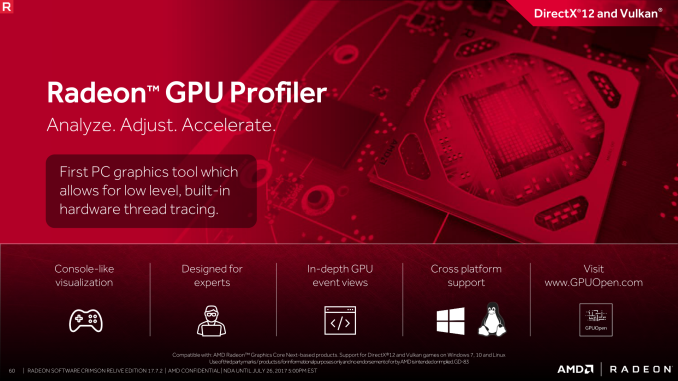
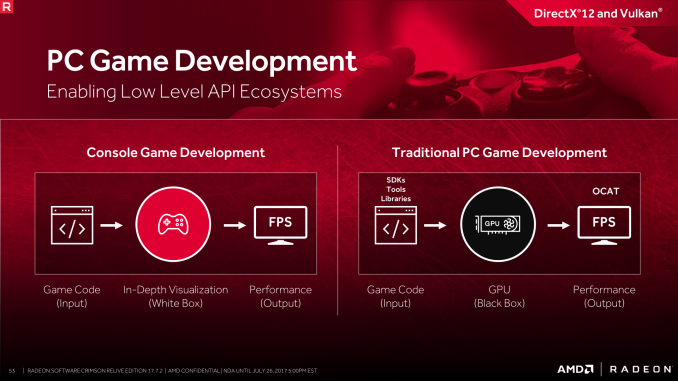

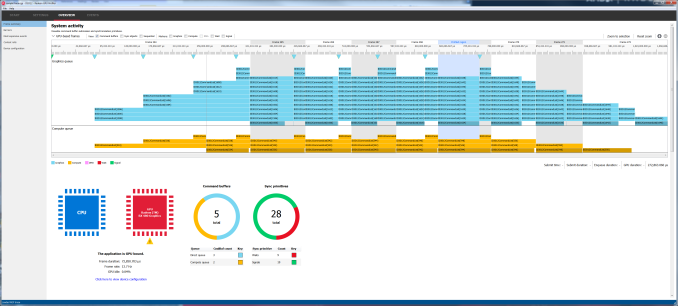

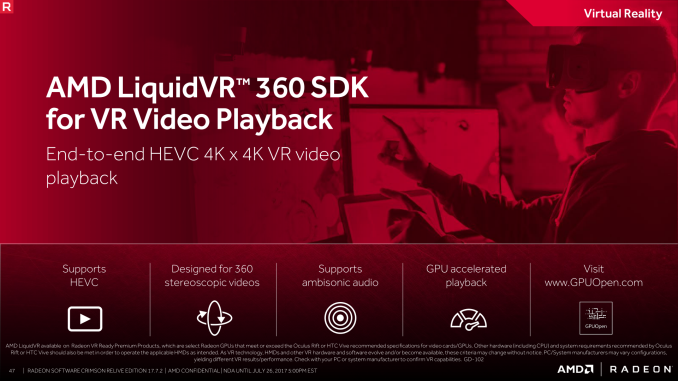
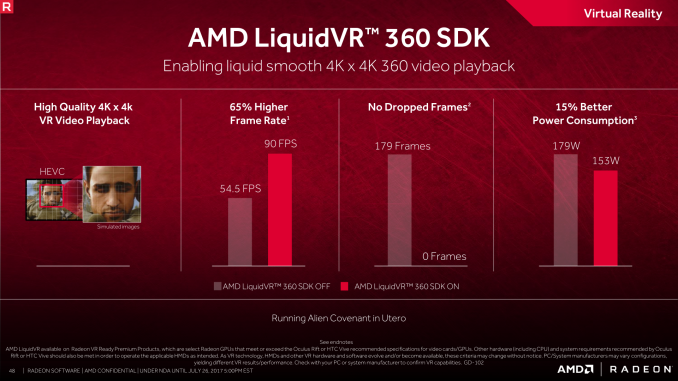
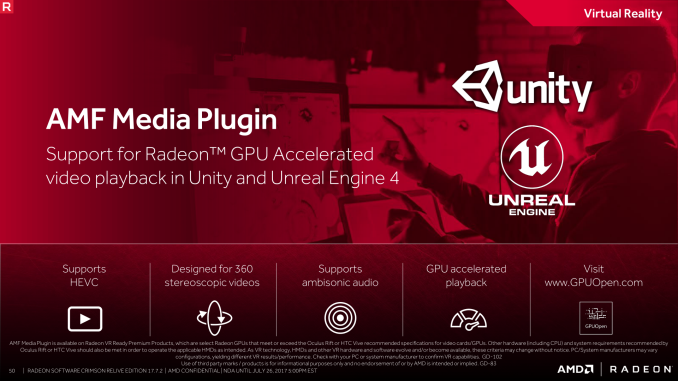








30 Comments
View All Comments
nampo - Wednesday, July 26, 2017 - link
There is no "Enhanced Sync" setting in my R9 !Cryio - Thursday, July 27, 2017 - link
It's only for Polaris currently. It will be backported to GCN 1.2 and possibly GCN 1.1 later.Alexvrb - Thursday, July 27, 2017 - link
Wow that's nifty I actually wasn't expecting them to support E-Sync outside of Polaris.ET - Thursday, July 27, 2017 - link
It's nice that AMD has a feedback option, but meanwhile the AMD Issue Reporting Form doesn't work, and I haven't been able to report bugs. (In this case, bad interlaced video playback.)StevoLincolnite - Thursday, July 27, 2017 - link
I half expected a couple of benchmarks somewhere or something. Hah.Oh well. Downloading away. I miss the old GUI though, it was better suited to the PC, interested to see if I notice anything on my RX 580... AMD really needs some decent GPU's and stop playing around in the mid-range though. Vega can't come fast enough.
Threska - Thursday, July 27, 2017 - link
Hopefully with this release Deus Ex: Mankind Divided will lose some of the lag it experiences when ran too long.Alexvrb - Thursday, July 27, 2017 - link
That sounds like either a Deus Ex issue or a "help my system is heatsoaked" issue.novingate - Sunday, July 30, 2017 - link
yesnovingate - Sunday, July 30, 2017 - link
<a href="http://www.novingateco.ir/">درب اتوماتيک</a>bluewaffles - Monday, November 20, 2017 - link
https://bluewafflesdisease.info/ I read the title too fast, for a second I assumed they had tweaked the radeon software interface. I miss the old interface. The one that had a hierarchy on the left and the settings on the right. It was simple, intuitive and easy to use. Even after few years I am